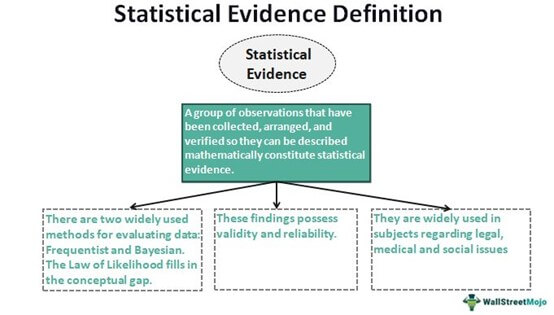Table Of Contents
What is Statistical Evidence?
Statistical evidence in research is a collection of observations that have been organized, validated, and gathered in a way that allows them to be expressed in mathematical form. In other words, it is a summary of the collective opinion or observation of subject-matter experts regarding a specific subject.

According to research, the statistical data can rise an argument's persuasiveness. Its persuasiveness is at its highest when it incorporates statistical and narrative evidence. Statistical techniques helps to deepen the understanding of the data. The evidence puts forth the validity and consistency of the inference as a substantiation of the hypothesis put forth.
Key Takeaways
- One can give the statistical evidence definition as study findings and conclusions that possess validity and reliability and help one to arrive at conclusions regarding a subject.
- It comprehends the composition of beliefs and the relationships between its constituent parts. The use of evidence can be targeted at certain areas of the belief system to substantiate the arguments.
- Frequentist and Bayesian theories are the two most common statistical techniques used to calculate the evidence.
- This evidence finds utility in many cases. In addition to evaluating hypotheses, one can use statistics to estimate an unknown that is difficult or impossible to measure.
Statistical Evidence Explained
Statistical evidence in research is frequently employed in a subject matter to provide statistics or information that serves as the basis for a conclusion. Gaining acceptance of information (conclusion) is a significant component of an argument or hypothesis. To do that, the receiving party has to provide an explanation (justification) on how the facts support a conclusion. Understanding the working of material functions within the framework of the belief system is essential for it.
The use of statistical evidence is calculative and strategic. They can support or deconstruct certain elements of belief by understanding the structure and relation between the elements in the system. Meta-analysis finds frequent use in compiling statistical data to minimize Type I error (false positive) and Type II error (false negative). Using the Subjective Probability Model offers a way to use the data by altering probability in beliefs to improve the efficacy of a case.
There are two popular methods for evaluating data: frequentist and Bayesian. The Law of Likelihood fills in the conceptual gap, and its application to statistical theory yields a frequentist methodology that avoids the inherent logical inconsistencies of the current methods while preserving the fundamental characteristics that have made them valuable scientific tools.
On the other hand, the Bayesian approach uses the data and results from past experiences and bases them on analyzing the current data to form plausible conclusions.
There are also circumstances where the statistical evidence may be ineffective. This set of scenarios is called the "base rate fallacy." They occur in situations where the given statistical information is generally accepted, but the examples given to demonstrate it contradict the base rate.
Examples
Given below are statistical evidence examples that give readers a basic understanding of the concept:
Example #1
John owns a pizza outlet. He also wants to open a new showroom in the nearby locality. The aim here is to expand the business and attract more new customers. For this purpose, he decides to advertise on various media and platforms. In that case, John decides to advertise first in the newspaper about new pizza flavors in town. For this reason, he will need to review his previous data from ad campaigns to predict how many different platforms the ad should appear on. If the p-value is higher than 0.05, the result is insignificant. This means it is not wise to go ahead with the previous ad style. Therefore, this previous example of analysis is statistical evidence.
Example #2
In hopes of bettering the business, John wanted to give attractive offers through the company's website for the new pizza outlet. He noticed that there was an increase in the website traffic because of the attention these offers got. On the calculation of the p-value, he had arrived at a value of 0.02, which is significantly below 0.05, indicating that the offers did attract new customers. In short, this is evidence that a new idea had an impact on the business.
Why is it Important?
In the evolution of the discipline of statistics, the idea of statistical evidence has proven to be fairly tricky. However, there is a belief that properly collected data contains information about the solutions to scientifically relevant issues. Moreover, the evidence makes it possible to assess assertions supported by numerical data and assist in identifying credible from dubious conclusions.
Moreover, they also help in the following:
- They help in perceiving the severity of the situation.
- Estimation of vulnerability to threat
- Arriving at the required solution.
The use of statistical data to support assertions has a significant impact on each element. The use of statistics typically clarifies the concept or argument. In certain cases, they allow for making calculated, well-informed decisions. In addition, it can point out the issue and help derive a solution to the problem. They can have a huge impact in case of legal, medical, and social issues and are hence of primary importance.

